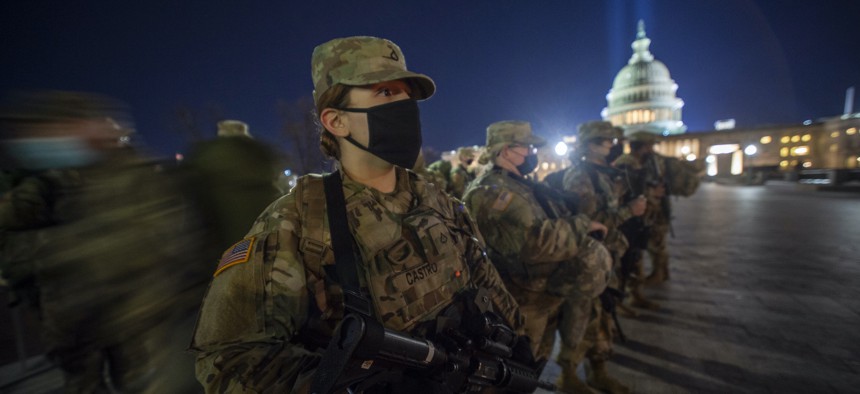
Oklahoma Army National Guard Soldiers receive instructions as they begin their first shift providing security near the U.S. Capitol building, Jan. 19, 2021. U.S. National Guard / Sgt. Anthony Jones
No Pentagon Wrong-Doing in Jan. 6 Reaction, Inspector General Finds
“DOD officials did not delay or obstruct” Guard troops who arrived at the U.S. Capitol hours after insurrectionists stormed it.
Despite widespread criticism of the Defense Department for its reaction to the Jan. 6 attack on the U.S. Capitol building, a report out Thursday from the department’s inspector general found that its actions “were appropriate, supported by requirements, consistent with the DOD’s roles and responsibilities...and compliant with laws, regulations, and other applicable guidance.”
The report largely affirms the timeline that the Defense Department has published of the events in question. Others have noted significant gaps in that timeline and inconsistencies in officials’ public discussions of the day’s events.
Then-acting Defense Secretary Chris Miller in particular has come under scrutiny for the three-hour gap between the D.C. National Guard commander’s request for authorization to send troops to the Capitol and their arrival on the scene. In March, Maj. Gen. William Walker, then head of the D.C. Guard, testified that his 2 p.m. call to Army leaders was joined by Gen. Walter Piatt, the director of the Army staff; and Lt. Gen. Charles Flynn, then a deputy Army chief of staff, who advised against the swift deployment of additional troops, citing poor “optics.”
During his testimony, Walker said “unusual” restrictions had hobbled the Defense Department response. The inspector general report makes no reference to any unusual restrictions. “We also determined that DOD officials did not delay or obstruct the DOD’s response” it reads.
Then-Army Secretary Ryan McCarthy has said he literally ran to the office of the Defense Secretary to seek authorization to send troops. National Guard reinforcements arrived after 5 p.m. that evening, after authorization from Miller.
The report notes that before Jan. 6, Miller “sought to ensure that civilian agencies had no additional support requirements for the DOD, and that the DOJ would be designated as the lead federal agency if circumstances developed to necessitate a federal response to potential civil disturbances.”
Two weeks after the riot, Miller defended his handling of the event, telling reporters that he was concerned about using too much force after criticism of the National Guard’s handling of police-reform protests the previous spring.
“The same people that morning that were concerned I was going to be a part of some military coup to overthrow the republic based on the fact ‘If there are military people on the streets can you imagine what signal that would send to America,’ the same people who did that that day were, by the end of the day, begging for armed soldiers in the Capitol,” he said.
The military has also taken heat for the military’s handling of the Jan. 6 riot. In March, Joint Chiefs Chairman Gen. Mark Milley told reporters that the National Guard acted swiftly and appropriately given the chaotic nature of the day and the byzantine structure of civilian, federal, and municipal authorities that govern the security of the Capitol.
“The D.C. National Guard...went from a cold start. And they had troops there in two and a half, three hours. Delta Force takes—well, I won’t even say what it takes because it's probably classified, but they reacted faster than our most elite forces.”
While the report does not fault any Defense Department personnel for the Jan. 6 reaction, it does offer some recommendations for swifter civil defense operations in the D.C. region in the future, such as reviewing U.S. Northern Command’s role in providing support to civilian authorities in the District, better scenario-based training for the D.C. National Guard, and a review of how federal agencies can request assistance from the Guard.




